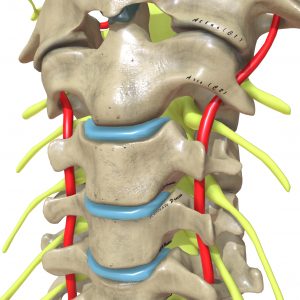Neck pain: Causes, aggravating factors and what to do about it
Pain in the neck, with or without symptoms extending into one or both arms is quite a common complaint we see in practice. At UMOYA Chiropractic our objective is always to distinguish between causes and factors that tend to aggravate symptoms. This might sound simple, even logical, however in practice this is not so easy. In the article below I will provide you with a brief anatomy overview of the neck, and understanding how a shift from “normal” can result in various secondary conditions such as neck pain, headaches and arm pain.
Neck pain: First things first
Anatomy of the neck
The neck consists of seven bones called vertebrae, separated by intervertebral disks, and connected by small joints, called facet joints. In-between the vertebrae are little tunnels where nerves of the arm exit. These tunnels, called foramen, have different borders, each with the potential to irritate the nerve passing through it. Ligaments and muscles surround the neck – the former providing support and stability, the latter also contributing to support and stability but more importantly, controls the movement of the neck.

Function of the neck
The main function of the neck is to support the head, and to allow us to orientate our head in relation to our environment. Is someone calling your name? Having sufficient movement in your neck allows you to turn your head to search for the person calling you. Driving in your car and want to change lanes? Thanks to the mobility in your neck, you should be able to check your blindspot. The neck would have had a relatively easy job had it not been for the heavy head on top of it. The average weight of the human head (that’s the brain, including the skull, the eyes, the teeth etc.) is around 4.5 to 5 kg. That’s the equivalent of a bowling ball or an average pumpkin!
Alignment of the neck
When we look at the placement of one neck vertebra on top of the other, it doesn’t form a straight tower like when we put blocks on top of one another. In fact, when you look at it from the side, normally you will see a C-shaped arch called a “lordosis”, with the hollow of the C curve pointing towards the back of the neck. This is the optimal, anatomical positioning of the neck vertebrae. It is the most efficient position for your neck and the amount of stress on it’s supporting structures (disc, facet, muscles and ligaments) is diminished. Any shift from this normal positioning is abnormal and causes increased pressure on the facet joints and disks between the vertebrae, and increased tension along ligaments and muscles of the neck. You may begin to experience this as stiffness in your neck, which may over the course of years start contributing to neck pain.
Pain producing structures in the neck
Pain is an unpleasant sensation and emotional experience that links to tissue damage. It’s a conscious awareness that something, somewhere, is being irritated or damaged. In the neck, the most common structures producing pain signals are the facet joints, tears in the intervertebral disc (called a hernia), the nerves, and muscles.
Neck pain: The primary cause
When the neck is in proper alignment, as described above, the anatomical structures are in their most efficient position, allowing for proper movement of one vertebra on top of the other. This equates to normal structure, normal function, and no symptoms. Prior to you developing symptoms such as neck stiffness or even pain, a shift from the normal integration between structure and function has to occur first. This usually occurs in the absence of symptoms, but sets up a series of incorrect movement patterns which eventually culminates in secondary conditions such as neck stiffness, pain, headaches and even arm symptoms.
What keeps our head on our neck?
We are all aware of the five “special” senses: vision, hearing, balance, taste, and smell. But there is another sense, sometimes described as the “sixth sense” and it’s called proprioception: the sense of self-movement and body position. It is vitally important for our brain to know where all the different parts of our bodies are. As such, an intricate interplay between visual cues from our eyes, balance receptors in our ears, and special receptors (located within muscles, ligaments, the intervertebral disks and facet joints of our neck) help us maintain proper head positioning. Our brain is dependent on this information it receives from the body (called proprioception) in order to control things such as body posture and movement. Optimal alignment and optimal movement provides proper information to our brain, which is a hallmark of Neuro-Functional Integration. A shift from this optimal alignment and movement results in incorrect information to the brain. The brain in turns send out commands based on faulty information. This neurological miscommunication, called a Neuro-Functional Shift, often results in incorrect movement patterns and postural changes, such as tilting of the head to one side or more commonly, shifting of the head forwards.

What aggravates a Neuro-Functional shift?
Physical aggravating factors
Are you reading this on your mobile phone? Tablet? Chances are that you are. A study was done to look at the changes in pressure on the neck structures with changes in head/neck positioning. Keeping in mind that the neutral position of the neck is the most efficient position, as the head tilts forward, “forces seen by the neck surges to 12,15kg at 15 degrees, 18kg at 30 degrees, 22kg at 45 degrees and 27kg at 60 degrees” [1]. Bending your head/neck down once or twice to look down is not a problem – we’ve been doing it all through history. However, according to research from RescueTime, an app to monitor phone use, people spend an average of three hours and 15 minutes on their phones every day, looking at their devices on average 58 times per day! [2]. Activities such as frequent phone or tablet use, prolong sitting behind a computer, or in a car driving, can contribute to shifts occurring from the normal ideal positioning of the neck. Not being aware of these contributing factors, or even worse, not changing these behaviours once you are aware of their consequences, will continue to negatively influence the quality of your neuro-functional integration.

Emotional aggravating factors
Don’t think that only physical body positions play a role. Have you ever had a fright? What’s the instinctive reaction? To flinch, right? That is a protective mechanism from the brain to protect us from danger. No image watching a movie and something scary is about to happen. What do you do? Again, you tend to flinch. Even though you are safely at home and out of harms way, the reaction is the same. Our brain is not able to distinguish between physical or imagined threats, and reacts in the same way: to flex, moving your head forwards, and your arms forwards as if to protect yourself. Our exposure to various emotional stressors on a day to day basis has also skyrocketed. Stress about exams, deadlines at work, worries about loved ones, all contribute to this body positioning.

These shifts in head and neck alignment, tends to increase pressure on the anatomical structures in the neck. The problem for us however is that these structures do not immediately produce pain signals. Since the process takes place over months and often years, our body has time to adapt and to compensate, but this can go on only for so long. Eventually, this continued loading on the neck will result in secondary conditions, most commonly starting as neck stiffness, and progressing towards neck pain, headaches, and even shoulder and arm pain.
So knowing what you know now, what can you do?
Understand that there are always two parts to the problem: one is your awareness of the pain (i.e. the symptom), and the other is the underlying shift(s) which have occurred (i.e. the cause). What is your objective? Numb your awareness of the pain, or address the underlying cause(s)? For the former, there are many effective symptomatic based treatments at your disposal, ranging from pain medication, massages, exercises or even surgery. Addressing the cause(s) requires more participation and investment from you. Becoming more aware of your body is a good start, as well as critically assessing your environment for possible aggravating factors. Ergonomics is always a big factor, but even having the best workstation setup is no solution for lack of movement or incorrect movement patterns which have become your “normal”. Time, repetition and dedication is often needed if you really want to make a long term change in your body.
If your objective is to determine the cause, then you would be glad to know that at UMOYA Chiropractic we begin with determining where the underlying shifts may have occurred. And even though this topic is about symptoms relating to one section of the spine, one has to realise that the spine is in fact one whole unit. Yes, it does consist of the neck, middle back, low back and pelvis, but these regions are not separate sections – they form part of the whole structure, where one part influences the other. It should therefore not be strange to consider that your neck pain, might not even be coming from your neck…
[1] Hansraj, K. K. (2014). Assessment of stresses in the cervical spine caused by posture and position of the head. Surgical Technology International, 25, 277–279. Retrieved from http://www.ncbi.nlm.nih.gov/pubmed/25393825
[2] MacKay, J. (n.d.). Screen time stats: How your phone impacts your workday – RescueTime. Retrieved March 30, 2020, from https://blog.rescuetime.com/screen-time-stats-2018/

